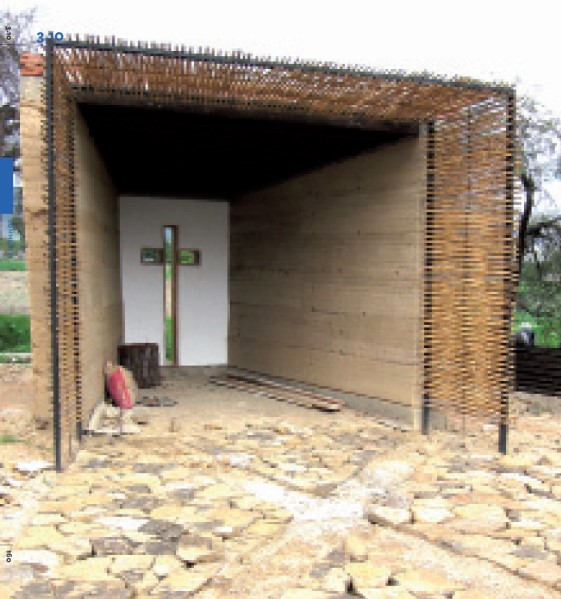| Location | San Bartolo Coyotepec, Oaxaca, Mexico |
| Date | 2010 |
| End User | 40 visitors per week |
| Project Sponsor | Mayordomo Benito Guzman Canseco |
| Design Team | Luis Cabral, João Caeiro, Fulvio Capurso |
| Funders | Mayordomos Benito Guzman Canseco Don Julio; Various donated labor and supplies |
| Cost | $1500 USD |
| Area | 160 sq ft/15 sq m (covered area) |
| Site | 860 sq ft/80 sq m (surrounding stone-paved area) |

A side view of San Isidro Chapel. Walls create visual barriers from the road. Photo: Joao Caeiro and Fulvio Capurso
More than one third of the earth’s population lives or works in structures made from earth. However western building techniques are considered better in many parts of the world where raw materials were traditionally used. This is the case in the town of San Bartolo Coyotepec, in central Oaxaca, Mexico. For 4000 years the area’s natives used earth as a structural building block, but today this method is often considered a mark of poverty. The design team behind the community’s small Chapel of San Isidro Labrador sought to undo this stigma and tap into Mexican history by using the region’s indigenous building materials.
The chapel is made of large red bricks of compacted earth. Architects João Caeiro and Fulvio Capurso wanted to show that this traditional practice could lead to a contemporary space and teach community members how to do it themselves. They met with local officials to conceptualize the project and the land and materials were donated. “The media makes our people think that the best thing is to build with industrialized materials,” explains then-Mayordomo Benito Canseco Guzmán, the elected community member responsible for the chapel and current president of the Council of Oaxaca.

The interior of the small chapel. People visit mostly to pray. Photo: Joao Caeiro and Fulvio Capurso
An educational model for efficient, structurally-sound rammed earth building techniques, the chapel was built with the help of 200 community members. It is constructed of tamped earth bricks, made from a mixture of two types of earth and a small amount of cement that were molded in a wood box form. “The walls were treated with nopal cactus juice,” Caeiro says. “This is a technique used since ancient times; the juice contains a natural binding agent which acts as a sealant and is effective in waterproofing the mud clay walls.” The chapel entrance is framed by a lattice of reeds woven through lightweight metal that serves as a modern homage to the region’s traditional fences.
Local artists contributed seven black ceramic tiles embedded into the north plaza wall that highlight the history of the town from pre-Hispanic Zapotec culture.
A covered rectangle with one completely open wall and a cross-shaped window in the rear, the chapel is surrounded by a stone-paved open area. It is a gathering space for the annual celebration of San Isidro, patron saint of the farmers. Making the chapel’s construction a community-based project has helped the people of San Bartolo Coyotepec regain an appreciation for the earth-building technique. Four hundred people came to the opening ceremony and about 45 people visit the chapel every week.















READ OR LEAVE A COMMENT